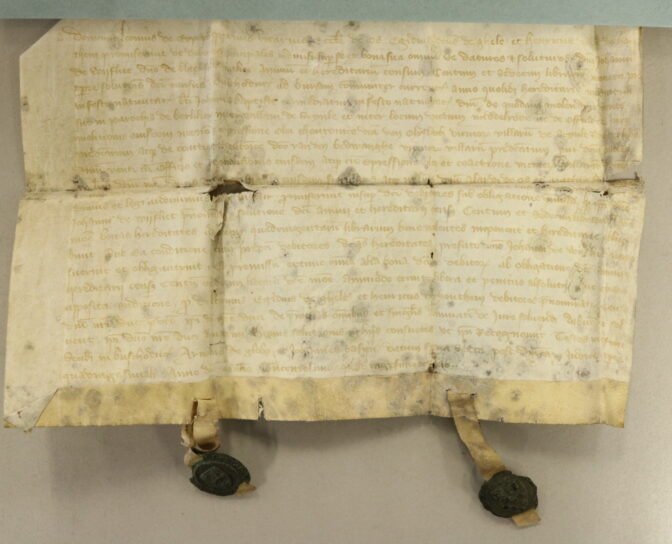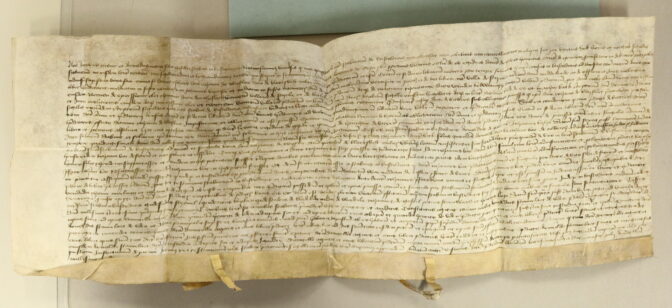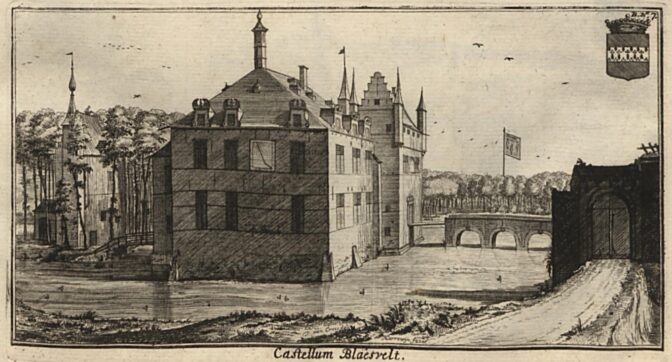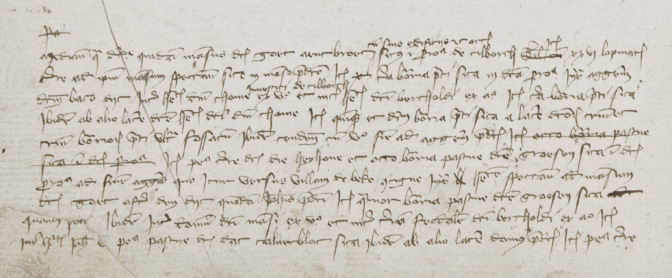This is the twenty-second post in a series about my possible line of descent from Eleanor of Aquitaine. In the first post, I explained how I discovered the possible line, and how I am going to verify it one generation at a time. In the last post, I proved that my seventeenth great-grandfather Johan van Wijfliet was the son of Lijsbeth van Mieren.
Lijsbeth van Mieren, daughter of Jan van Wijfliet
Research into Jan van Wijfliet turned up two records that mentioned his father’s wife:
- A 1349 rent register named Lijsbeth van Mieren, daughter of Lord Jan van Wijfliet and Lijsbet van Mieren as wife of Jan Bac.
- A 1391 annuity mentioned Jan Back and the Lady Lijsbeth, his wife.
These and other records will be analyzed for evidence about the identity of Lijsbeth van Mieren’s parents.
Life interest for Lijsbeth van Mieren
A 1349 rent register from the city of Mechelen (also known as Mechlin, now in Belgium) shows that Lord Jan Wijfvliet established a rent (life interest or pension) for his illegitimate daughter Lijsbeth van Mieren, whom he had with Lijsbeth van Mieren. Jan Wijfliet and his wife paid the money for the rent.
The entry says “Jan Bacs wife,” which by itself could refer to either the daughter or the mother. The previous blog post explains why it had to be the daughter who was married to Jan Bac.
The entry for Lijsbeth van Mieren follows two entries for Lady Margriet, natural daughter of Lord Roelf Pypenpoys that he had with Marie van Lattem. Lord Jan van Wijfliet and his wife paid for that second rent as well.1

1349 rent register
The city ledgers of Mechelen recorded the payments they made on these pensions. The payment of 10 pounds to Lady Lijsbeth van Mieren is recorded in the city ledgers of 1350 to 1369. For 1350 to 1356, they are recorded with or next to the payments to Lady Margriet Pipenpoy.2

1353 ledger
In three cases, a name was written after the entry for Lijsbeth van Mieren:
- The 1360 entry mentioned Aert van den Bossche.3
- The 1364 entry mentioned Aerd de Bije.4
- The 1369 entry mentioned H Cools.5
The limited information provided in the ledgers and scarcity of sources for this period for commoners prevented identification of these three people. Their last names are all in use in and around Oisterwijk, where Jan Back and Lady Lijsbeth lived.6 A plausible explanation for their appearance in the rent register is that they collected the rent on Lady Lijsbeth van Mieren’s behalf. Mechelen is about 90 km/55 miles from Oisterwijk, which makes unlikely that Lijsbeth or her husband would have gone there in person every year.
These types of “lijfrentes” [life rents] were paid for life. Since Lijsbeth van Mieren last appeared in the city ledgers in 1369, she probably died in 1369/1370.
Annuity for Lady Lijsbeth, wife of Jan Bac
On 5 May 1391, an annuity was founded in the Oisterwijk church for the deceased Jan Back and Lady Lijsbeth, his wife, and Aert Berthout and Lady Lijsbeth, his wife.7
Annuities were founded after death to have masses said for the souls of the deceased. Jan Bac was still living at some point between 1390 and 1394, when Berthout, son of Jan Bac Berthout’s son van [from] Tilburg sold a rent from the mill in Corvel in the parish of Tilburg to his brother Jan van Wijfliet.8 The lack of the word “quondam” [late] before Jan Bac’s name suggests he was still living at that time. Jan Back must have died between 1390 and 5 May 1391, so the annuity was founded shortly after his death.
The 1369/1370 death date for Lady Lijsbeth van Mieren inferred from the ledgers of Mechelen shows she too was deceased before the foundation of the anniversary in 1391.
Rent of 116 pounds
A transfer of a rent of 116 pounds provides more evidence for the identity of lord Jan van Wijfliet, who was mentioned as the father of Lijsbeth van Mieren in the 1349 rent register.
On 31 March 1349, Jan van Wijfliet, Lord of Blaersveld, knight, received a rent of 116 pounds of the windmill in Berlicum. The original charter survives.9
On 2 August 1356, Johannes Back, son of the late Aert called Berthout Bac van Tilburg, steward of the Duke, gained possession of that rent. The 1349 transfer to Jan van Wijfliet and the 1356 transfer to Johannes Back are both copied into a charter of 1434. The original 1356 charter does not survive.10
The charter describes how the rent was abandoned when Johannes Back obtained it in 1356. As will be shown in the next blog post, Jan van Wijfliet, lord of Blaersveld, was an illegitimate son of Duke John II of Brabant. Jan van Wijfliet died in 1356.11 As a bastard, his inheritance would have reverted back to the landlord, who at that time was his half-niece Duchess Johanna of Brabant. It appears that the Duchess chose to assign the rent to Jan Back after Jan van Wijfliet’s death.
We know that Jan Back’s wife Lijsbeth van Mieren was the daughter of a lord Jan van Wijfliet. Her father must have been this Jan van Wijfliet, lord of Blaersveld. As an illegitimate child herself, Lady Lijsbeth van Mieren would not have been legally entitled to an inheritance, but her half-cousin could choose to provide for her by assigning the rent formerly held by her father to her husband.
Pipenpoy connection
The 1349 rent register and 1350-1356 city ledgers from Mechelen imply a close connection between Jan van Wijfliet and the Pipenpoy family:
- Jan van Wijfliet paid for the rent of Lady Margriet, illegitimate daughter of lord Rudolph Pipenpoy in 1349. That entry preceded the rent that Jan van Wijfliet established for his own illegitimate daughter, Lady Lijsbeth van Mieren.12
- In the Mechelen city ledgers, the entries for the payments for that Lady Margriet and the payment to Lady Lijsbeth van Mieren were often next to each other or in the same entry.13
An aldermen’s court record from Mechelen from 1350 mentions Margriet, lady of Blaersfeltt.14
Margriet, Lady of Blaasveld was the daughter and heir of Rudolph Pipenpoy, lord of Blaasveld. Her husband Jan van Wijfliet succeeded her father as lord of Blaasveld.15 As Rudolph van Pipenpoy’s son-in-law and heir, Jan van Wijfliet would have been the logical choice to pay for the rent for Rudolph Pipenpoy’s illegitimate daughter.
The nearest large town to Blaasveld was Mechelen, which explains why both Rudolph Pipenpoy and Jan van Wijfliet established the rents for their illegitimate daughters there.
The close connection between Jan van Wijfliet and Rudolph Pipenpoy is confirmed by the Eda Boeck, a feudal register of Brabant, which shows that Jan van Wijfliet succeeded to a fief previously held by Rudolph Pipenpoy.16 The Eda Boeck gave an overview of fiefs in 1432, though several of the entries reflected earlier situations that had not been updated.
Naming patterns
Naming patterns also support the conclusion that Lijsbeth van Mieren, the wife of Jan Back, was the daughter of Jan van Wijfliet.
In 1406/1407, the children of the late Jan Bac Berthout’s son divided his estate. These children were:
- Berthout Bac
- Jan van Wijfliet
- The late Elsbena, wife of Jan van Dordrecht, with daughter Hadewijch, wife of Nicolaas Steenwech.17
This estate division shows that Jan Back and Lijsbeth van MIeren had a son Jan van Wijfliet. Listed after Berthout, Jan van Wijfliet was probably the second son, who would traditionally have been named after his maternal grandfather. In this time and place, it was not unusual for the second son to be named after the maternal grandfather by his full name rather than just a first name.18
Daughter Elsbena may have been named after her maternal grandmother. Elsbena and Lijsbeth are both versions of Elisabeth. Elsbena could have been named after Lijsbeth van Mieren’s mother, who according to the 1349 rent register was also called Lijsbeth van Mieren.
Conclusion
The 1349 rent register of Mechelen identified Lijsbeth van Mieren, the wife of Jan Bac, as the illegitimate daughter of lord Jan Wijfliet and Lijsbeth van Mieren.
Two blocks of evidence showed that her father Lord Jan van Wijfliet was Jan van Wijfliet, lord of Blaasveld:
- The 1349 rent register showed that lord Jan van Wijfliet also paid for the rent for Margriet, illegitimate daughter of Rudolph Pipenpoy. The city ledgers had the payments for this Margriet and Lijsbeth van Mieren in consecutive or combined entries. Jan van Wijfliet, lord of Blaasveld, was the husband of Lady Margriet Pipenpoy, daughter and heir of Rudolph Pipenpoy, lord of Blaasveld.
- In 1349, Jan van Wijfliet, Lord of Blaasveld, held a rent of 116 pounds that was awarded to Jan Back in 1356.
Lijsbeth van Mieren named her second son Jan van Wijfliet, apparently after her father including his last name.
The combination of evidence proves that Lijsbeth van Mieren, the wife of Jan Bac, was the illegitimate daughter of Jan van Wijfliet, lord of Blaasveld, and Lijsbeth van Mieren.
That’s twenty-one generations down, seven to go!
Next up: Generation 22 – Jan van Wijfliet
Sources
- Mechelen, rent book 1349-1367, fol. 45v, Lijsbeth van Mieren; records of the city of Mechelen, fonds K – Rentes, series I, nr. 3; Mechelen City Archives, Mechelen, Belgium.
- Mechelen, city ledgers, no. 28 (1350):40, 29 (1351):34, 30 (1352):51, 31 (1353):43v, 32 (1354):63, 33 (1355):40, 34 (1356):51, 54; 35 (1357):29, 32; 36 (1358): 46, 49v; 38 (1360):10v, 20, 39 (1361):33, 40 (1362): 37v, 45; 41 (1363):29, 38v; 43 (1364):25, 34; 44 (1365):21, 32v; 45 (1366):20v, 33v; 46 (1367):20v, 32v; 47 (1368):23, 36; 48 (1369):16 ; records of the City of Mechelen, Fonds B – Comptes, serie I; Mechelen City Archives, Mechelen.
- Mechelen, city ledgers, no. 38 (1360):10v.
- Mechelen, city ledgers, no. 43 (1364):34.
- Mechelen, city ledgers, no. 48 (1369):16.
- See for example “Inventaris van het archief van de Schepenbank van Moergestel, 1455 – 1811,” finding aid 822, Regionaal Archief Tilburg (http://www.regionaalarchieftilburg.nl : accessed 18 August 2019), Word-files attached to general protocol. Also, “Plaatsingslijst van het archief van de Schepenbank en Eninge van Oisterwijk, 1418-1811,” finding aid 847, Regionaal Archief Tilburg (http://www.regionaalarchieftilburg.nl : accessed 18 August 2019), Word-files attached to general protocol. For Oisterwijk as residence of Jan Back, see Feudal Office of Brabant, “Spechtboek,” 1374 to about 1460, fol. 205, Kirchove; photocopy in call no. 276, Record Group 360, BHIC.
- “Liber anniversatorium,” register of annuities (1532); call no. 7, aquisitions of Oisterwijk, Record Group 777; Regionaal Archief Tilburg, Tilburg.
- Aldermen’s Court (‘s-Hertogenbosch), Bosch Protocol 1390-1394, fol. 77, Bac to Wijfliet; call no. 1179, record group 14, Erfgoed ‘s-Hertogenbosch.
- Leonis van Erp et al to Johannes van Wijfliet, charter (31 March 1349); call no. 261, Reformed Citizens’ Orphanage ‘s-Hertogenbosch, Record Group 0212; Erfgoed ‘s-Hertogenbosch, ‘s-Hertogenbosch.
- Aldermen of ‘s Hertogenbosch, vidimus of charters of 1349 and 1356 (25 July 1434); call no. 260, record group 0212, Erfgoed ‘s-Hertogenbosch.
- Jan van Boendale, Brabantsche Yeesten, vol. 6, section LXXII, “Van heren Ots brueder kinderen, ende van den graven”; transcribed version, Digitale Bibliotheek Nederlandse Letteren (https://www.dbnl.org/tekst/boen001brab01_01/boen001brab01_01_0269.php : accessed 31 May 2019).
- Mechelen, rent book 1349-1367, fol. 45v, Lady Margriet van Pipenpoy and Lijsbeth van Mieren.
- Mechelen, city ledgers, no. 28 (1350):40, 29 (1351):34, 30 (1352):51, 31 (1353):43v, 32 (1354):63, 33 (1355):40, 34 (1356):51, 54.
- Aldermen’s Court (Mechelen), protocol, 1345-1354, fol. 107v, Marg: de Blaersfelt (1350); fonds G – Schepenakten [Aldermen’s records], series I, nr. 1; Mechelen City Archives, Mechelen.
- “Archief van de schepenbank en het dorpsbestuur van Blaasveld, 1323-1796,” finding aid, Rijksarchief in Belgie (https://search.arch.be/nl/zoeken-naar-archieven/zoekresultaat/ead/index/eadid/BE-A0511_106440_106674_DUT : accessed 18 August 2019), introduction.
- Feudal Office of Brabant, “Eda Boeck,” about 1432, fol. 296, Jan van Wijflet; photocopy in call no. 278, Shadow Archives 20th Century; Brabants Historisch Informatie Centrum, Den Bosch; citing Feudal Office of Brabant, National Archives, Brussels, Belgium call no. 11.
- Aldermen’s Court (‘s-Hertogenbosch), Bosch Protocol 1406-1407, fol. 196v-197, Bac/Wijfliet estate division; call no. 1185, record group 14, Erfgoed ‘s-Hertogenbosch.
- J.A. de Boo, Familiewapens: Kentekens van Verwantschap [Family Coats of Arms: Signs of Kinship] (The Hague: Centraal Bureau voor Genealogie, 2008), 171.










Yvette, you continue to amaze me. Your posts have been so interesting and I look forward to the next 7 posts.
And you’ve reached minor nobility! This looks very promising!
Yvette, respect!
You have provided proof that a strong presumption is true.
The Pijlijsers are not only descendants of Jan I of Brabant but also of Jan II of Brabant.
For the rest of the line I have my information from Project Medlands, I am very curious about the further results of your research.
Such wonderful old records you can use [and read!], for walking back your ancestors. I’m learning lots just watching your process. The handwriting in some of these very early records – although in a stylized lettering – tends to be very clear. 7 more generations-? Wow!!
Hi! Just this morning I found out that I’m (possibly) related to the Wijtvliet family, so finding your blog has been a delight! The big ‘missing link’ we have is that our ancestor Petrus Wijtvliet is probably descended from Lijsbeth, but we don’t know through which of her children. Did you happen to see a Petrus mentioned anywhere? In any case, I hope you’ll be able to pick up this project again soon!
I only know if one child, Jan. I did not see a Petrus in early Wijtvliet records.